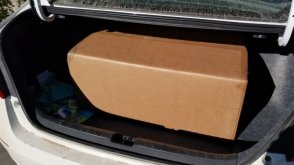HighTechLab
AKA Dexter - CTO of Current Connected, LLC
- Joined
- Sep 23, 2019
- Messages
- 1,691
I've read nothing but good things about sol-ark inverters.
I live in a totally off-grid scenario (no grid connections). Our daily usage at this time of the year is around 20-30 KWh. We have a 14kw Wacker Neuson backup diesel generator, and 64x CALB CA180 batteries.
Currently we have a FoxPower Inverter/charger, but it's practically identical to the signieer inverters that a few other members are buying up from Electric Car Parts Company. The capability is great, however, the idle draw of 3.69 amps at 52 volts is atrocious. In the 2 1/2 years that I've ran it full time, it's over 2 MWh of power that has been turned into heat in my electrical room. Around 5KWh per day of just idle power.
I've been running my PLC data logging, and we only rarely have spikes over 8000 watts, typical load is 1000 (at night) - 2400 watts during the day, but up to 6000 watts during the day in summer with ACs running.
Sol-Ark units are extremely efficient. They also have extremely low idle draw. Seems like a no brainer to me to be more conservative on the power I already have.
My plan already was to expand my solar array to be around 150x 250 watt panels on a fixed pole-style ground mount rack. This would require me to add either 6 more Outback FM80s or with a sol-ark I can utilize the 12kw of solar input per unit. My thought is starting with 1 of the sol-arks and then in the future add a second one and parallel them up.
Another thought driving this is they can charge batteries at 180 amps versus the 100 amps of the unit I currently have. Right now I have one 12kw inverter that is always in "invert" mode and another one that turns on via PLC control when the generator starts up and charges the batteries...The loads on the property never transfer to the generator to prevent overloading the generator, rather just continue to pull off the DC buss. The Sol-Ark can work with the generator like generator support, so now we can utilize the generator's prime power output range, therefore saving fuel and reducing the hour count on the generator.
I can't think of anything really that doesn't make more sense with this unit, other than the cost. I've been quoted around 6800 and one distributor down to 6400. My plan tomorrow is to find someone local that can get it for around 6400, and then pull the trigger and get my first unit.
Missing something here, or sound about right?
I live in a totally off-grid scenario (no grid connections). Our daily usage at this time of the year is around 20-30 KWh. We have a 14kw Wacker Neuson backup diesel generator, and 64x CALB CA180 batteries.
Currently we have a FoxPower Inverter/charger, but it's practically identical to the signieer inverters that a few other members are buying up from Electric Car Parts Company. The capability is great, however, the idle draw of 3.69 amps at 52 volts is atrocious. In the 2 1/2 years that I've ran it full time, it's over 2 MWh of power that has been turned into heat in my electrical room. Around 5KWh per day of just idle power.
I've been running my PLC data logging, and we only rarely have spikes over 8000 watts, typical load is 1000 (at night) - 2400 watts during the day, but up to 6000 watts during the day in summer with ACs running.
Sol-Ark units are extremely efficient. They also have extremely low idle draw. Seems like a no brainer to me to be more conservative on the power I already have.
My plan already was to expand my solar array to be around 150x 250 watt panels on a fixed pole-style ground mount rack. This would require me to add either 6 more Outback FM80s or with a sol-ark I can utilize the 12kw of solar input per unit. My thought is starting with 1 of the sol-arks and then in the future add a second one and parallel them up.
Another thought driving this is they can charge batteries at 180 amps versus the 100 amps of the unit I currently have. Right now I have one 12kw inverter that is always in "invert" mode and another one that turns on via PLC control when the generator starts up and charges the batteries...The loads on the property never transfer to the generator to prevent overloading the generator, rather just continue to pull off the DC buss. The Sol-Ark can work with the generator like generator support, so now we can utilize the generator's prime power output range, therefore saving fuel and reducing the hour count on the generator.
I can't think of anything really that doesn't make more sense with this unit, other than the cost. I've been quoted around 6800 and one distributor down to 6400. My plan tomorrow is to find someone local that can get it for around 6400, and then pull the trigger and get my first unit.
Missing something here, or sound about right?




